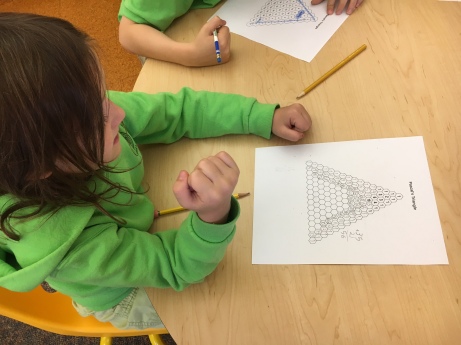Almost every week, I read or tell my second grade class a story about a famous mathematician. Recently, we have been reading from the book Mathematicians Are People Too: Stories from the Lives of Great Mathematicians and the students have been really enjoying the stories – they ask interesting questions and have lively discussions.
Last week we read about Blaise Pascal. The students were intrigued by how his father hid math and science books from him, by his invention of the first “calculator” and of course by Pascal’s Triangle. Exploring the triangle seemed like a very natural follow-up activity.
I printed out a mostly blank Pascal’s Triangle with just the first few rows filled in and with “spots” for the first 15 rows. The goal was for the students to fill in a few more rows and then I’d give them already filled in triangles for them to look for patterns and color them in. However, we never made it to this second part because the students got so into filling in the entries that they refused to stop.
I was very impressed with how hard they were willing to work to compute the entries. I was also pleased to see that most of them noticed the symmetry at some point and used it to their advantage. I think that for children that are still mastering 2-digit addition, making it into the thousands with minor help is a great feat!




I guess I will have to show them the cool patterns some other time (in fact, I hope to come back to it multiple times because there is so much to explore about this beautiful triangle). Oh, and at the end they insisted on taking the triangles home with them because they wanted to continue working on them!

One approach that is fun and easier for creating triangles is to do them in modular arithmetic. Mod 10 is easy for the kids to compute, mod 2 and mod 3 have worked well for us to color code the values. These ideas are essentially from the book Number Devil.
Also, your kids might be interested to know the triangle has a longer/broader history than just Pascal: Wiki history section.
LikeLike